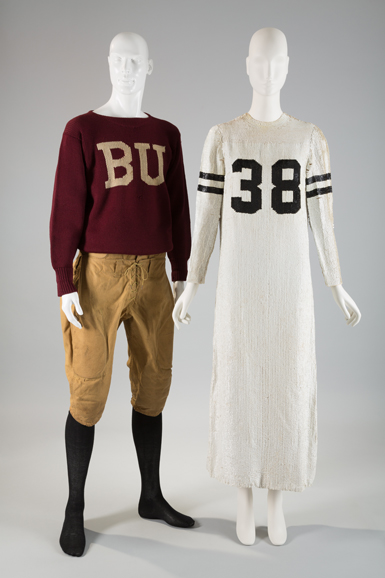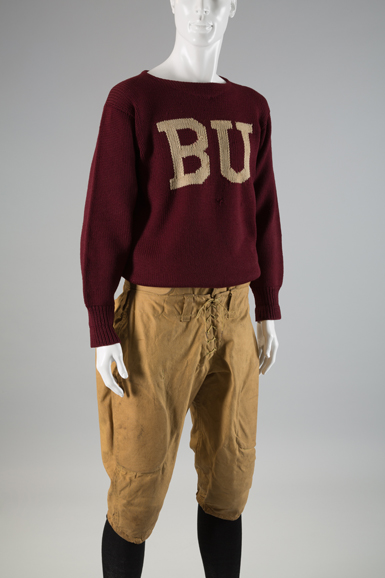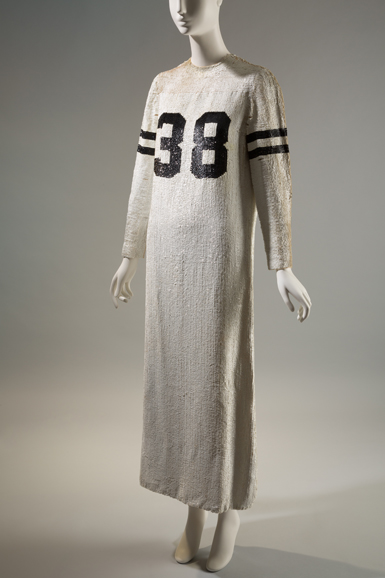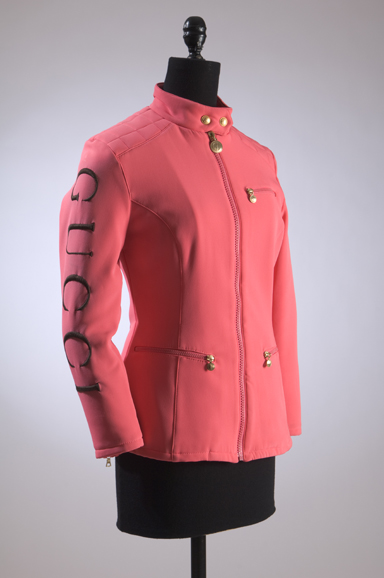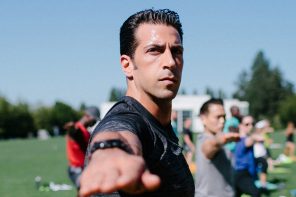The dress, with a number emblazoned on its chest and telltale stripes on its sleeves, immediately calls to mind the classic football jersey.
To the contemporary eye, it’s simply one of the many fashions featured in “Uniformity,” an exhibition that continues through Nov. 19 at The Museum at FIT in Manhattan.
But at the time of its 1967 creation, it was quite daring, says Emma McClendon, assistant curator of costume at the museum and organizer of the exhibition.
“It was incredible at the time Geoffrey Beene did it,” she says, noting the American designer’s “very literal” translation of the sports jersey into a full-length creation in silk and sequins was groundbreaking. The mixing of the decidedly masculine lines of the football uniform with a woman’s silhouette certainly stirred things up.
As McClendon says, “It was incredibly subversive.”
But today, McClendon agrees, such examples of athletic gear influencing everyday wear barely raise an eyebrow, which is part of the message of the exhibition that explores how uniforms — military, work, school and sports — have influenced the world of fashion.
The show — a collection of more than 70 objects from the museum’s holdings that fills its Fashion & Textile History Gallery — is a lively walk through time, taking the visitor, for example, from vintage sailor uniforms to a 1992 Jean Paul Gaultier sailor-influenced ensemble. It further explores the uniform-fashion connection through Chanel’s 2015 Parisian waiter-inspired “Brasserie Gabrielle” ensemble and a 1998 Comme des Garçons wool ensemble that pays homage to the U.S. Army’s World War I service uniform. Along the way, we meet nurses and flight attendants, fast-food workers and mechanics, pilots, schoolgirls, chauffeurs, maids and more.
It is on the sportswear, though, that — in deference to this issue’s theme — we focus, easy enough as the worlds of sport and fashion seem to overlap more and more.
Need evidence? Look no further than the prevalence of yoga wear as street fashion or baseball caps or letterman-influenced jackets that serve as statements of allegiance to brand rather than team.
Of the historical connection, McClendon says, “I think that there’s been a lot of influence from sports uniforms, particularly as we get into the 20th century and later into the 20th century.”
Sports uniforms, she notes, were first designed to help band a team together, both psychologically — as in a team approach — and in a practical sense, easily identifying allies versus foes. Uniforms also, McClendon adds, help spectators to follow along.
When it comes to fashion, it’s the uniforms’ bold lines, bright colors and sleek designs, she says, that offer the strongest influences.
“From an aesthetic standpoint, that’s really where we see a fashion response to uniforms.”
“Uniformity” showcases a wealth of examples, including sports and sports-influenced fashions ranging from a man’s circa-1925 wool track uniform to a 1979 Yankees cap in navy cotton. There are competitive cycling jerseys from the 1970s and a 2015 ensemble by Stella Jean that incorporates a football T-shirt. An eye-catcher is definitely Tom Ford’s 1995 version of a ski jacket designed for Gucci, a sleek salmon-pink design that would be equally at home on a shopping excursion along Madison Avenue as it would on the slopes.
McClendon points to the heyday of the sports-uniform influence as the 1990s, what she calls “the age of logo mania and branding.” Sports uniforms provided an easy way to turn a ready-made style into a brand ambassador, as clearly demonstrated by a
circa-1993 Vivienne Westwood cap. In the company’s signature tartan, the jaunty hat, as exhibition text says, served not only as a walking advertisement for the brand but also identified the wearer as “a member of the Westwood team.”
It’s a fascinating combination, as McClendon explains of the two elements blurring to create a new aesthetic.
“Uniforms are all about achieving standardization… whereas fashion is really more about personal style and creativity. It really seems like they are butting heads.”
But digging deeper unearths some common ground.
“Uniforms are all about looking appropriate in any given cultural moment,” she notes, something many fashions also facilitate.
And like fashion, uniforms adapt: “We think of uniforms as being stagnant, but uniforms change.”
With active attire broadening thanks to advances in materials and our embracing a “more casual phase of dressing,” McClendon says the crossover will likely continue.
“We see all these things started out as active wear, use-driven, performance-driven” outfits suddenly being worn — and considered appropriate — for a trip to the store or a movie matinee.
But as the influence continues, McClendon notes, there is always going to be a little competition, as on the playing field.
“This push-pull between the athletic wear and fashion is ongoing.”
For more, visit fitnyc.edu/museum.

